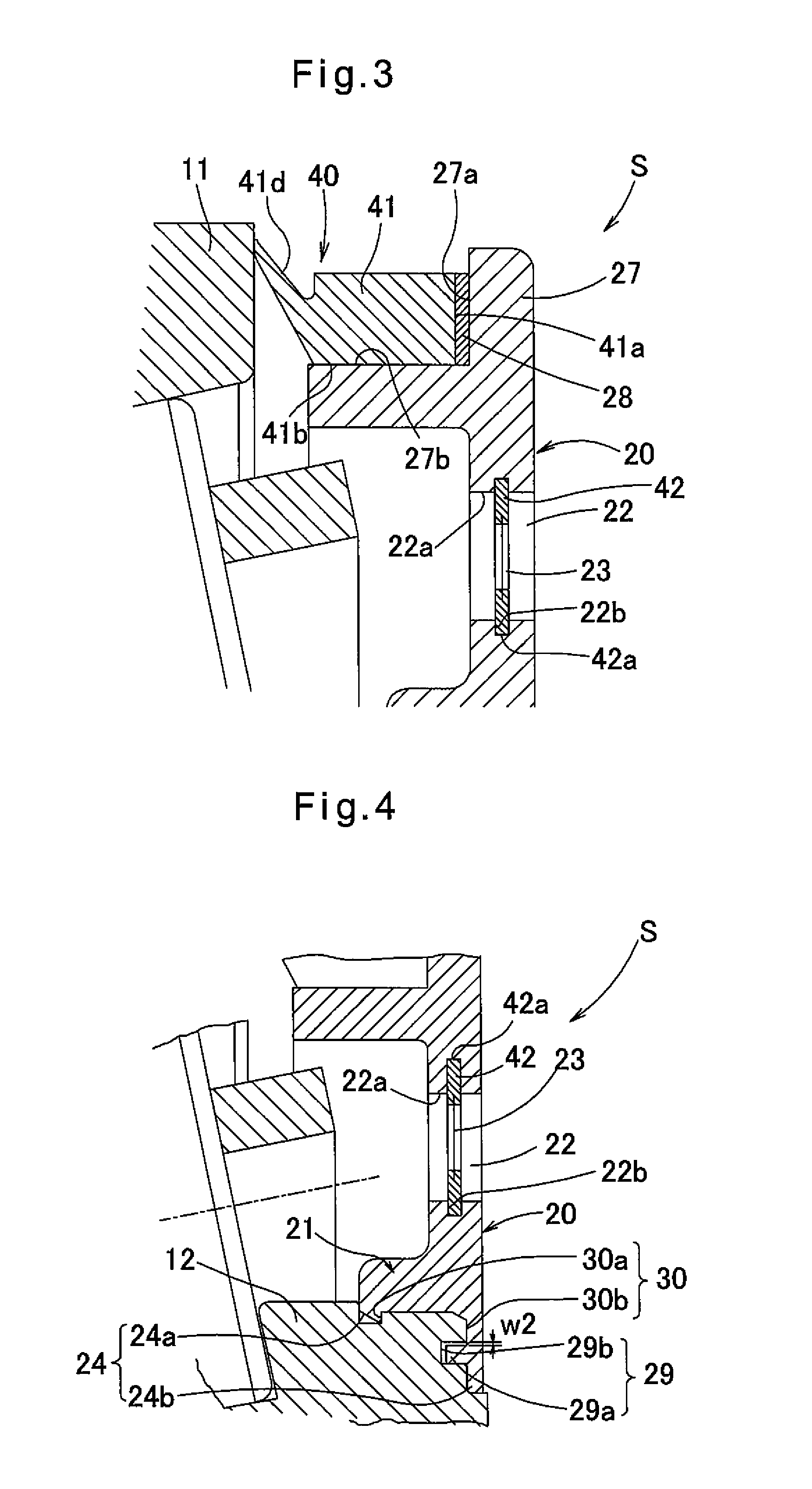Rolling bearing
- Summary
- Abstract
- Description
- Claims
- Application Information
AI Technical Summary
Benefits of technology
Problems solved by technology
Method used
Image
Examples
third embodiment
[0162]FIG. 5 shows the present invention, in which the annular member 40, forming the lip 41, is formed with a positioning shoulder 41c on its radially inner surface. The positioning shoulder 41c is configured to engage an end edge 27c (or a shoulder) of the lip mounting portion 27 of the seal ring 20, thereby axially positioning the annular member 40 relative to the seal ring 20.
[0163]In this and other embodiments, a seal ring fitting portion 31 of the engaging portion 21, defined between the inner protrusions 24a and the outer protrusions 24b, is fitted on an inner race fitting portion 32 between the inner seal grooves 30a and the outer seal grooves 30b with an interference fit. The seal ring fitting portion 31 and the inner race fitting portion 32 are fitted together with a predetermined interference fit by heating and expanding the resin seal ring 20 and fitting the thus expanded seal ring 20 onto the inner race 12. The interference fit improves sealability of the seal ring 20.
fourth embodiment
[0164]FIG. 6 shows the present invention, in which the lip mounting portion 27 of the seal ring 20 has a sectional shape of the Japanese character “”.
[0165]Since the lip mounting portion 27 has a “”-shaped section, the lip mounting portion 27 protects the annular member 40 against external force applied to the seal ring 20 from around the seal ring 20. Since the lip mounting portion 27 has a “”-shaped section, if the annular member 40 is fixed in position using an adhesive or a filler, the lip mounting portion 27 can prevent leakage of such an adhesive or a filler.
[0166]Different variations are feasible for the anti-pull-out means 43, which prevents separation of the annular member 40 and the seal ring 20 from each other in the axial direction, and for the anti-rotation means 44, which prevents circumferential rotation of the annular member 40 relative to the seal ring 20.
[0167]In a fifth embodiment, shown in FIG. 12(a), one variation of the anti-pull-out means 43 and one variation ...
fifth embodiment
[0168]In FIG. 12(a), the anti-pull-out means 43 and the anti-rotation means 44 consist of recesses a and protrusions b formed on one and the other of the respective radially opposed abutment surfaces of the annular member 40 and the seal ring 20 and meshing with the radially opposed protrusions b and recesses a, respectively. In particular, the recesses a are formed in the outer peripheral surface 27b of the lip mounting portion 27 of the seal ring 20, while the protrusions b are formed on the inner peripheral surface 41b of the annular member 40. The recesses a and the protrusions b may extend the entire circumferences of the outer peripheral surface 27b and the inner peripheral surface 41b, respectively. Otherwise, the recesses a and the protrusions b may consist of a plurality of groups, each groups consisting of circumferentially spaced apart recesses or protrusions.
[0169]Due to engagement of the protrusions b and the recesses a, the recesses a and the protrusions b prevent (as ...
PUM
 Login to View More
Login to View More Abstract
Description
Claims
Application Information
 Login to View More
Login to View More - R&D
- Intellectual Property
- Life Sciences
- Materials
- Tech Scout
- Unparalleled Data Quality
- Higher Quality Content
- 60% Fewer Hallucinations
Browse by: Latest US Patents, China's latest patents, Technical Efficacy Thesaurus, Application Domain, Technology Topic, Popular Technical Reports.
© 2025 PatSnap. All rights reserved.Legal|Privacy policy|Modern Slavery Act Transparency Statement|Sitemap|About US| Contact US: help@patsnap.com



